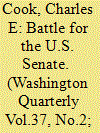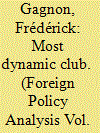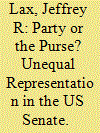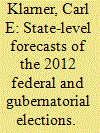|
|
|
Sort Order |
|
|
|
Items / Page
|
|
|
|
|
|
|
| Srl | Item |
| 1 |
ID:
133167


|
|
|
|
|
| Publication |
2014.
|
| Summary/Abstract |
The battle for control of the U.S. House of Representatives was over before it even started, but the fight for control of the U.S. Senate is proving to be a knock-down, drag-out affair that could easily go either way.
Control of the U.S. House is pretty much a settled affair. Republicans occupy 93 percent of the congressional districts that GOP presidential nominee Mitt Romney carried in 2012, and Democrats hold 96 percent of the districts that Obama won. As a result, there are very few "fish out of water," or Republicans sitting in Democratic-leaning districts or Democrats in GOP-tilting districts. Yes, there are a large number of open House seats this cycle, but most are in districts which safely belong to one side or the other. It would seem that the next realistic shot Democrats have at winning control of the House would come in 2022, after the next round of redistricting takes place in 2021. The 2018 and 2020 gubernatorial and state legislative elections will determine which party in each state has the dominant hand in the redistricting process. Republicans had it in most states in 2011, and Democrats want it badly in 2021.
|
|
|
|
|
|
|
|
|
|
|
|
|
|
|
|
| 2 |
ID:
159579


|
|
|
|
|
| Summary/Abstract |
Relying on a multilevel approach to the behavior of members of Congress, this article explains why Arthur Vandenberg, J. William Fulbright, and Jesse Helms were particularly active chairs of the Senate Foreign Relations Committee. It draws parallels between their careers and shows that similar factors explain why they were active: (a) crucial international events convinced them to play a leading role in the foreign policy debate; (b) the US political and social environments created policy windows for their activism; and (c) they possessed the necessary skills, interests, and convictions to play such a role. Our approach also explains why the three chairs displayed different types of activism (Vandenberg relied on legislative and nonlegislative collaboration with Harry Truman, Fulbright primarily on nonlegislative opposition to Lyndon Johnson, and Helms on legislative and nonlegislative opposition to Bill Clinton). Furthermore, this article explains why Fulbright was less successful than Vandenberg and Helms in convincing Congress and the President to adopt key legislations he introduced in the Senate.
|
|
|
|
|
|
|
|
|
|
|
|
|
|
|
|
| 3 |
ID:
168531


|
|
|
|
|
| Summary/Abstract |
Recent work on US policymaking argues that responsiveness to public opinion is distorted by money, in that the preferences of the rich matter much more than those of lower-income Americans. A second distortion—partisan biases in responsiveness—has been less well studied and is often ignored or downplayed in the literature on affluent influence. We are the first to evaluate, in tandem, these two potential distortions in representation. We do so using 49 Senate roll-call votes from 2001 to 2015. We find that affluent influence is overstated and itself contingent on partisanship—party trumps the purse when senators have to take sides. The poor get what they want more often from Democrats. The rich get what they want more often from Republicans, but only if Republican constituents side with the rich. Thus, partisanship induces, shapes, and constrains affluent influence.
|
|
|
|
|
|
|
|
|
|
|
|
|
|
|
|
| 4 |
ID:
116464


|
|
|
|
|
| Publication |
2012.
|
| Summary/Abstract |
The election forecasts presented in this article indicate that control of the White House after the 2012 election is a tossup, that control of the US House will likely remain in Republican hands, and that although closely fought, the Republicans have the edge for control of the US Senate. These forecasts were made on July 15, 2012. Obama was predicted to receive 51.3% of the two-party popular vote, 301 electoral votes, and to have a 57.1% chance of winning the Electoral College. The year 2012 was forecast to be one of stasis for the US House, with almost no change in the number of seats controlled by the Republicans: they were forecast to pick up two seats, and to have a 75.6% chance of maintaining their majority. Lastly, the Republicans were predicted to pick up five seats in the US Senate and have about a 61.6% chance of attaining majority control.
|
|
|
|
|
|
|
|
|
|
|
|
|
|
|
|
|
|
|
|
|